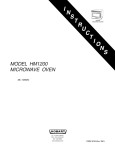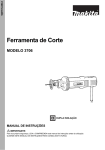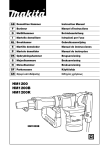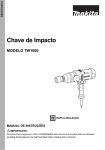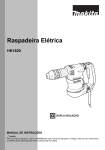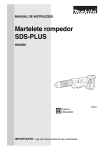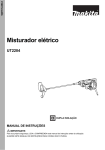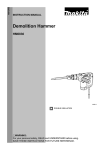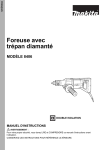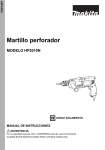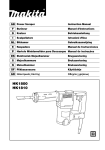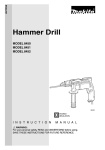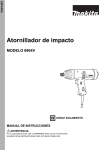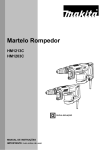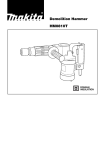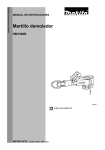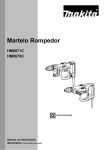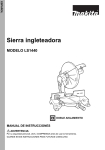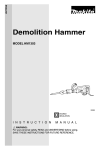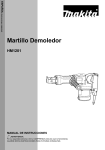Download HM1200 HM1200B HM1200K Demolition Hammer
Transcript
Demolition Hammer HM1200 HM1200B HM1200K HM1200B DOUBLE INSULATION SPECIFICATIONS Model HM1200 Blows per minute ............................................................................................... 2,000 Overall length..................................................................................................... 480 mm Net weight .......................................................................................................... 8.3 kg HM1200B 2,000 490 mm 9.4 kg HM1200K 2,000 490 mm 9.1 kg • Due to our continuing programme of research and development, the specifications herein are subject to change without notice. • Note: Specifications may differ from country to country. For European countries only EC-DECLARATION OF CONFORMITY ENH101-5 Noise and Vibration of Model HM1200 We declare under our sole responsibility that this product is in compliance with the following standards of standardized documents, EN60745, EN55014, EN61000 in accordance with Council Directives, 89/336/EEC and 98/37/EC. ENG006-2-V4 The typical A-weighted noise levels are sound pressure level: 97 dB (A) sound power level: 108 dB (A) Uncertainty is 3 dB (A). – Wear ear protection. – The typical weighted root mean square acceleration value is 12 m/s2. These values have been obtained according to EN60745. Yasuhiko Kanzaki CE 2005 Director MAKITA INTERNATIONAL EUROPE LTD. Noise and Vibration of Model HM1200B Michigan Drive, Tongwell, Milton Keynes, Bucks MK15 8JD, ENGLAND ENG006-2-V4 The typical A-weighted noise levels are sound pressure level: 98 dB (A) sound power level: 109 dB (A) Uncertainty is 3 dB (A). – Wear ear protection. – The typical weighted root mean square acceleration 2 value is 12 m/s . These values have been obtained according to EN60745. Responsible manufacturer: Makita Corporation Anjo Aichi Japan Noise and Vibration of Model HM1200K ENG006-2-V4 The typical A-weighted noise levels are sound pressure level: 94 dB (A) sound power level: 105 dB (A) Uncertainty is 3 dB (A). – Wear ear protection. – The typical weighted root mean square acceleration value is 12 m/s2. These values have been obtained according to EN60745. 2 \ 2 1 3 1 2 1 2 5 4 6 3 4 7 8 9 5 6 12 10 11 7 8 3 13 Symbols The following show the symbols used for the tool. Be sure that you understand their meaning before use. ❏ Read instruction manual. ❏ DOUBLE INSULATION ❏ Only for EU countries Do not dispose of electric equipment together with household waste material! In observance of European Directive 2002/96/EC on waste electrical and electronic equipment and its implementation in accordance with national law, electric equipment that have reached the end of their life must be collected separately and returned to an environmentally compatible recycling facility. 4 ENGLISH Explanation of general view 1 2 3 4 5 Bull point Tool retainer Notched portion Side grip Clamp nut 6 7 8 9 10 Side handle Switch trigger Hex wrench Rear cover Screwdriver GENERAL SAFETY RULES 11 Brush holder cap 12 Lock nut wrench 13 Crank cap 11. Avoid accidental starting. Ensure the switch is in the off-position before plugging in. Carrying power tools with your finger on the switch or plugging in power tools that have the switch on invites accidents. 12. Remove any adjusting key or wrench before turning the power tool on. A wrench or a key left attached to a rotating part of the power tool may result in personal injury. 13. Do not overreach. Keep proper footing and balance at all times. This enables better control of the power tool in unexpected situations. 14. Dress properly. Do not wear loose clothing or jewellery. Keep your hair, clothing, and gloves away from moving parts. Loose clothes, jewellery or long hair can be caught in moving parts. 15. If devices are provided for the connection of dust extraction and collection facilities, ensure these are connected and properly used. Use of these devices can reduce dust-related hazards. GEA001-3 WARNING! Read all instructions. Failure to follow all instructions listed below may result in electric shock, fire and/or serious injury. The term “power tool” in all of the warnings listed below refers to your mains-operated (corded) power tool or battery-operated (cordless) power tool. SAVE THESE INSTRUCTIONS. Work area safety 1. Keep work area clean and well lit. Cluttered and dark areas invite accidents. 2. Do not operate power tools in explosive atmospheres, such as in the presence of flammable liquids, gases or dust. Power tools create sparks which may ignite the dust or fumes. 3. Keep children and bystanders away while operating a power tool. Distractions can cause you to lose control. Power tool use and care 16. Do not force the power tool. Use the correct power tool for your application. The correct power tool will do the job better and safer at the rate for which it was designed. 17. Do not use the power tool if the switch does not turn it on and off. Any power tool that cannot be controlled with the switch is dangerous and must be repaired. 18. Disconnect the plug from the power source and/ or the battery pack from the power tool before making any adjustments, changing accessories, or storing power tools. Such preventive safety measures reduce the risk of starting the power tool accidentally. 19. Store idle power tools out of the reach of children and do not allow persons unfamiliar with the power tool or these instructions to operate the power tool. Power tools are dangerous in the hands of untrained users. 20. Maintain power tools. Check for misalignment or binding of moving parts, breakage of parts and any other condition that may affect the power tools operation. If damaged, have the power tool repaired before use. Many accidents are caused by poorly maintained power tools. 21. Keep cutting tools sharp and clean. Properly maintained cutting tools with sharp cutting edges are less likely to bind and are easier to control. 22. Use the power tool, accessories and tool bits etc. in accordance with these instructions and in the manner intended for the particular type of power tool, taking into account the working conditions and the work to be performed. Use of the power tool for operations different from those intended could result in a hazardous situation. Electrical safety 4. Power tool plugs must match the outlet. Never modify the plug in any way. Do not use any adapter plugs with earthed (grounded) power tools. Unmodified plugs and matching outlets will reduce risk of electric shock. 5. Avoid body contact with earthed or grounded surfaces such as pipes, radiators, ranges and refrigerators. There is an increased risk of electric shock if your body is earthed or grounded. 6. Do not expose power tools to rain or wet conditions. Water entering a power tool will increase the risk of electric shock. 7. Do not abuse the cord. Never use the cord for carrying, pulling or unplugging the power tool. Keep cord away from heat, oil, sharp edges or moving parts. Damaged or entangled cords increase the risk of electric shock. 8. When operating a power tool outdoors, use an extension cord suitable for outdoor use. Use of a cord suitable for outdoor use reduces the risk of electric shock. Personal safety 9. Stay alert, watch what you are doing and use common sense when operating a power tool. Do not use a power tool while you are tired or under the influence of drugs, alcohol or medication. A moment of inattention while operating power tools may result in serious personal injury. 10. Use safety equipment. Always wear eye protection. Safety equipment such as dust mask, non-skid safety shoes, hard hat, or hearing protection used for appropriate conditions will reduce personal injuries. 5 OPERATING INSTRUCTIONS Service 23. Have your power tool serviced by a qualified repair person using only identical replacement parts. This will ensure that the safety of the power tool is maintained. 24. Follow instruction for lubricating and changing accessories. 25. Keep handles dry, clean and free from oil and grease. Installing or removing bull point or other bits (cold chisel, etc.) Important: Always be sure that the tool is switched off and unplugged before installing or removing the bit. For HM1200 (Fig. 1) Pivot the tool retainer to the side. (If it is difficult to move the tool retainer with your thumbs, tap it with a hammer.) Insert the bit into the tool barrel as far as it will go. Return the tool retainer to its original position to secure the bit. SPECIFIC SAFETY RULES GEB004-2 DO NOT let comfort or familiarity with product (gained from repeated use) replace strict adherence to hammer safety rules. If you use this tool unsafely or incorrectly, you can suffer serious personal injury. 1. Wear ear protectors. Exposure to noise can cause hearing loss. 2. Use auxiliary handles supplied with the tool. Loss of control can cause personal injury. 3. Hold tools by insulated gripping surfaces when performing an operation where the cutting tool may contact hidden wiring or its own cord. Contact with a “live” wire will make exposed metal parts of the tool “live” and shock the operator. 4. Wear a hard hat (safety helmet), safety glasses and/or face shield. Ordinary eye or sun glasses are NOT safety glasses. It is also highly recommended that you wear a dust mask and thickly padded gloves. 5. Be sure the bit is secured in place before operation. 6. Under normal operation, the tool is designed to produce vibration. The screws can come loose easily, causing a breakdown or accident. Check tightness of screws carefully before operation. 7. In cold weather or when the tool has not been used for a long time, let the tool warm up for a while by operating it under no load. This will loosen up the lubrication. Without proper warmup, hammering operation is difficult. 8. Always be sure you have a firm footing. Be sure no one is below when using the tool in high locations. 9. Hold the tool firmly with both hands. 10. Keep hands away from moving parts. 11. Do not leave the tool running. Operate the tool only when hand-held. 12. Do not point the tool at any one in the area when operating. The bit could fly out and injure someone seriously. 13. Do not touch the bit or parts close to the bit immediately after operation; they may be extremely hot and could burn your skin. 14. Do not operate the tool at no-load unnecessarily. 15. Some material contains chemicals which may be toxic. Take caution to prevent dust inhalation and skin contact. Follow material supplier safety data. To remove the bit, follow the installation procedure in reverse. For HM1200B & HM1200K (Fig. 2) Pull out and turn the tool retainer 180 degrees (1/2 turn). Then insert the bit into the tool holder with the notched portion on the bit facing back toward the tool retainer. Then pull out and turn back the tool retainer 180 degrees to secure the bit. Try to pull the bit out of the tool holder to make sure the retained bit before use. CAUTION: Never use B-type shank bits. They can cause damage to the tool. (For HM1200B) Side grip/Side handle (auxiliary handle) For HM1200 (Standard type) (Fig. 3) The side grip swings around to either side, allowing easy handling of the tool in any position. Loosen the side grip by turning it counterclockwise, swing it to the desired position and then tighten it by turning clockwise. For HM1200 (European type), HM1200B & HM1200K (Fig. 4) The side handle swings around 360° on the vertical as well as back and forth on the horizontal. Turn the clamp nut clockwise to secure the handle in the desired position. Switch action (Fig. 5) CAUTION: • Before plugging in the tool, always check to see that the switch trigger actuates properly and returns to the “OFF” position when released. • Do not tape, tie or otherwise secure the trigger in the “ON” position. To start the tool, simply pull the trigger. Release the trigger to stop. Chipping / Scaling / Demolition Hold the tool firmly with both hands. Turn the tool on and apply slight pressure on the tool so that the tool will not bounce around, uncontrolled. Pressing very hard on the tool will not increase the efficiency. SAVE THESE INSTRUCTIONS. WARNING: MISUSE or failure to follow the safety rules stated in this instruction manual may cause serious personal injury. 6 MAINTENANCE CAUTION: Always be sure that the tool is switched off and unplugged before carrying out any work on the tool. Replacement of carbon brushes (Fig. 6 & 7) Whenever carbon brushes must be replaced, they cut out the tool automatically. When this occurs, replace both carbon brushes at the same time. Use only identical carbon brushes. Lubrication (Fig. 8) This tool requires no hourly or daily lubrication because it has a grease-packed lubrication system. Lubricate the tool every time the carbon brushes are replaced. Run the tool for several minutes to warm it up. Switch off and unplug the tool. Remove the crank cap using a Makita lock nut wrench 35 (optional accessory). Rest the tool on the table with the bit end pointing upwards. This will allow the old grease to collect inside the crank housing. Wipe out the old grease inside and replace with a fresh grease (30 g). Use only Makita genuine grease (optional accessory). Filling with more than the specified amount of grease (approx. 30 g) can cause faulty hammering action or tool failure. Fill only with the specified amount of grease. Reinstall the crank cap and tighten with the lock nut wrench. Do not tighten the crank cap excessively. It is made of resin and is subject to breakage. To maintain product safety and reliability, repairs, maintenance or adjustment should be carried out by a Makita Authorized Service Centre. ACCESSORIES CAUTION: These accessories or attachments are recommended for use with your Makita tool specified in this manual. The use of any other accessories or attachments might present a risk of injury to persons. The accessories or attachments should be used only in the proper and intended manner. • Bull point • Cold chisel • Scaling chisel • Grooving chisel • Clay spade • Rammer • Bushing tool • Safety goggle 7 Makita Corporation Anjo, Aichi, Japan 883396C228








